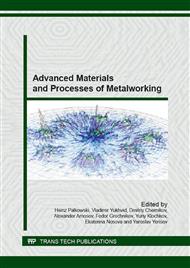[1]
V.M. Torbilo, Diamond burnishing, Mechanical Engineering, Moskow, (1972).
Google Scholar
[2]
F.I. Demin, N.D. Pronichev, I.L. Shitarev. The technology of manufacture of basic components of gas turbine engines: Proc. allowance. Mechanical Engineering, Moskow, (2002) 328.
Google Scholar
[3]
A.N. Reznikov, Abrasive and diamond processing materials: a handbook, Mechanical Engineering, Moskow, (1977).
Google Scholar
[4]
Tomasz Dyl. Effect of relative strain ratio on the reduce roughness surface layer tube holes after burnishing process (Journal of KONES Powertrain and Transport), Vol. 19, No. 2, (2012).
DOI: 10.5604/12314005.1137910
Google Scholar
[5]
F.I. Antoniuk, V.V. Kalmyks, V.A. Fedorov. Effect of surface roughness on the strength of the original diamond burnishing, Science and education (MSTU) N.E. Bauman, №12, (2014) 171-180.
Google Scholar
[6]
Mieczyslaw Korzynskia, Janusz Lubasa, Slawomir Swiradb, Kazimiera Dudekb. Surface layer characteristics due to slide diamond burnishing with a cylindrical-ended tool, Journal of Materials Processing Technology, Vol. 211, Issue 1, (2011), 84–94.
DOI: 10.1016/j.jmatprotec.2010.08.029
Google Scholar
[7]
Hongyun Luoa, Jianying Liub, Lijiang Wangb, Qunpeng Zhonga. Study of the mechanism of the burnishing process with cylindrical polycrystalline diamond tools, Journal of Materials Processing Technology, Vol. 180, Issues 1-3, (2006), 9-16.
DOI: 10.1016/j.jmatprotec.2005.03.041
Google Scholar
[8]
A.V. Kudryavtsev, V.V. Bolkunov. Influence of the method of fixing an instrument to the qualitytion surface of the part after the diamond burnishing, «Science: 21st Century», №4, (2010), 15-18.
Google Scholar
[9]
Feng Lei Li, Wei Xia, Zhao Yao Zhou, Jing Zhao, Zheng Qiang Tang. Analytical prediction and experimental verification of surface roughness during the burnishing process, International Journal of Machine Tools and Manufacture, Vol. 62, (2012).
DOI: 10.1016/j.ijmachtools.2012.06.001
Google Scholar
[10]
D.A. Tihonov, S.J. Tormanov, K.F. Martynenko. Research temperatures on contact surfaces during diamond burnishing speed steel with titanium-nitride coating, Thermal and technological aspects of quality management in engineering: the works of the II Intern. scientific and engineering. Conf. (Reznikovskii reading). - Togliatti: TGU, Part 1, (2008).
Google Scholar
[11]
S.N. Solov'ev. Determination of the temperature field at hardening and burnishing of friction surfaces spinning, Aerospace technics and technology: National Aerospace University. N.E. Zhukovsky «Kharkiv Aviation Institute», (2008) 15-17.
Google Scholar
[12]
I.E. Budeykina, Mathematical model of the process of diamond burnishing tool materials, In the world of scientific discoveries, № 4 (10), Part. 11, (2010) 69-72.
Google Scholar
[13]
S.N. Solovyov. Determination of the temperature field at hardening and burnishing surface friction spinning, Aerospace technics and technology: National Aerospace University. N.E. Zhukovsky «Kharkiv Aviation Institute», № 8 (55), (2008), 15-17.
Google Scholar
[14]
S.R. Abulkhanov, D.L. Skuratov, A.I. Khaimovich, A.N. Shvetcov. Analytical approach to determining of parameters which characterize surface layer quality of the parts hardened by a traveling diamond sphere, International Journal of Engineering and Technology (IJET), 5(6), (2014).
DOI: 10.4028/www.scientific.net/kem.684.387
Google Scholar
[15]
L.A. Galin. Contact Problems. Springer Science+Business Media, B.V. (2008) 318.
Google Scholar


